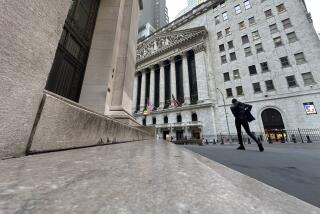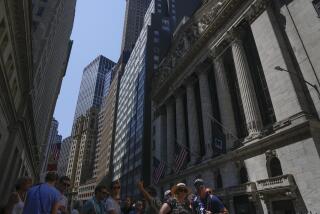Rescue plan sparks fallout
- Share via
NEW YORK — This wasn’t the reaction to his $700-billion rescue plan that Treasury Secretary Henry M. Paulson was hoping for.
Stock prices and the dollar plunged Monday -- and oil and other commodities soared -- on fears that the proposed bailout of the financial system could require a massive increase in government borrowing, push up interest rates and unleash new inflationary pressures. The Dow Jones industrial average tumbled almost 375 points.
And -- worst of all -- what if it doesn’t work?
“People worry that, if this doesn’t do it, there is no Plan C if Plan B doesn’t work,” said Ed Yardeni, president of Yardeni Research in Great Neck, N.Y. “Once you’ve essentially nationalized the capital markets, what more can you do?”
The volatile market moves came as members of Congress and the Bush administration negotiated changes to the bailout plan that could increase its cost.
“It’s certainly preferable to avoid a meltdown of the financial system,” said Martin Fridson, head of money-management firm Fridson Investment Advisors in New York. “But after you breathe a sigh of relief, you look down the road a little bit and you see mounting deficits, rising federal debt and the possibility of inflation.”
The Dow Jones industrial average dropped 372.75 points, or 3.3%, to 11,015.69, more than erasing its 368-point rally Friday. The Standard & Poor’s 500 index skidded 47.99 points, or 3.8%, to close at 1,207.09. The Nasdaq composite index gave up 94.92 points, or 4.2%, to 2,178.98.
Some investors who pulled money out of stocks poured it into commodities.
Oil for October delivery shot up $16.37 a barrel, a record increase, to settle at $120.92 on the New York Mercantile Exchange. It spiked as high as $130 in the last hour of trading. The price of an ounce of gold soared $43.30 to $903.90. An index of 19 major commodities surged 3.9%.
“People are seeing the bailout today as the fleecing of America,” said Fadel Gheit, senior energy analyst at Oppenheimer & Co. “They are expecting the dollar to sink even more, and there is no place for the investment money to go except back into commodities and oil.”
Inflation fears helped send the euro surging to $1.480 from $1.447 late Friday. The dollar’s 2.3% decline against the euro was the biggest on record. An index of the dollar’s value against other major currencies slid 2%.
“We’ve gotten past the knee-jerk positive reaction to the bailout, and now people are looking at the price tag,” said Win Thin, senior currency strategist at Brown Bros. Harriman & Co. in New York.
After leading the stock market up Thursday and Friday, financial stocks led the way down Monday, with an S&P; index of financial issues sinking 8.5% despite a ban imposed Friday by the Securities and Exchange Commission on “short selling” of financial stocks. A short seller borrows and then sells a stock in the expectation that the price will decline.
JP Morgan Chase declined 13%, and Wells Fargo was off 12%.
Shares of regional banks fell after analysts warned that they could benefit only marginally from the government rescue plan. There also was concern that smaller banks might have to endure further write-downs on bad mortgages if larger institutions lower the value of their holdings as part of the bailout.
Huntington Bancshares skidded 23%, and Regions Financial was off 21%.
Shares of Morgan Stanley surged early in the session after the Wall Street firm announced that Japan’s largest bank would buy a 10% to 20% stake for as much as $8.4 billion to shore up Morgan’s capital. But the stock retreated with the rest of the market to end the day down slightly. Goldman Sachs Group slid 7% the day after it and Morgan Stanley announced that they would become bank-holding companies, subjecting them to more government regulation.
Treasury yields spiked early in the day, but ended moderately higher after investors once again headed for the perceived safety of government bonds. The benchmark 30-year Treasury bond rose to 4.42% from 4.38% on Friday. The 10-year T-note rose to 3.84% from 3.81%.
The decline in the dollar helped push up oil and other commodities. But some oil industry analysts described the jump in crude as an anomaly, in part because the October futures contract expired Monday.
Andrew Lipow, a Houston consultant and former energy trader, said the price jump looked like “a classic short squeeze,” in which traders who bet that prices would fall get caught with commitments to deliver oil but can’t immediately find the needed barrels. The traders end up bidding higher and higher prices to draw out sellers and close their outstanding delivery commitments.
The unprecedented price increase caught the attention of regulators at the Commodity Futures Trading Commission, who said they would look for evidence of illegal market manipulation.
The oil contract for November delivery, which was actively traded Monday, rose a more modest $6.62 to $109.37 a barrel.
Phil Flynn, vice president and senior market analyst for Alaron Trading in Chicago, predicted the surge would be short-lived.
“Today, it’s all about the dollar, but that should stabilize,” he said. “I think oil could go as high as $120, but this is not sustainable in the long run.”
--
ron.white@latimes.com
elizabeth.douglass@latimes.com
--
Hamilton reported from New York, Douglass from San Diego County and White from Los Angeles.
More to Read
Inside the business of entertainment
The Wide Shot brings you news, analysis and insights on everything from streaming wars to production — and what it all means for the future.
You may occasionally receive promotional content from the Los Angeles Times.











